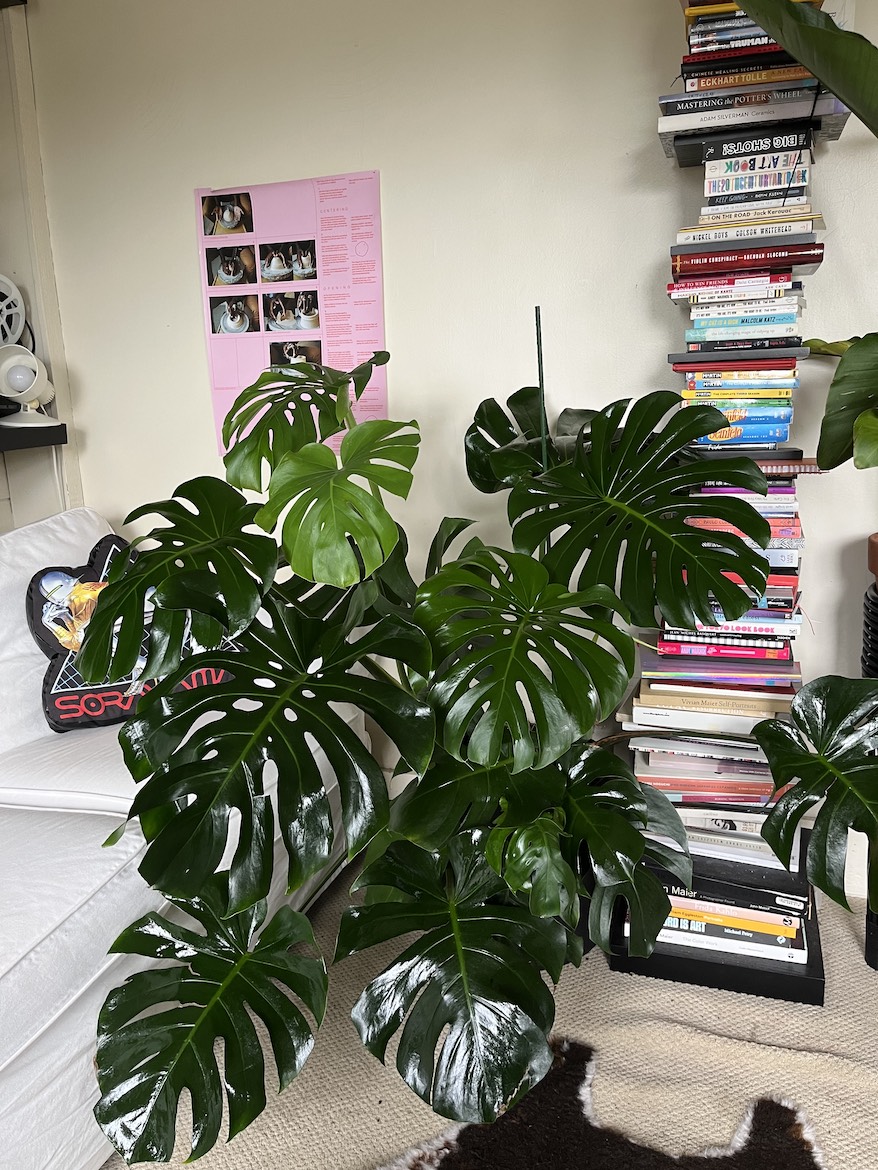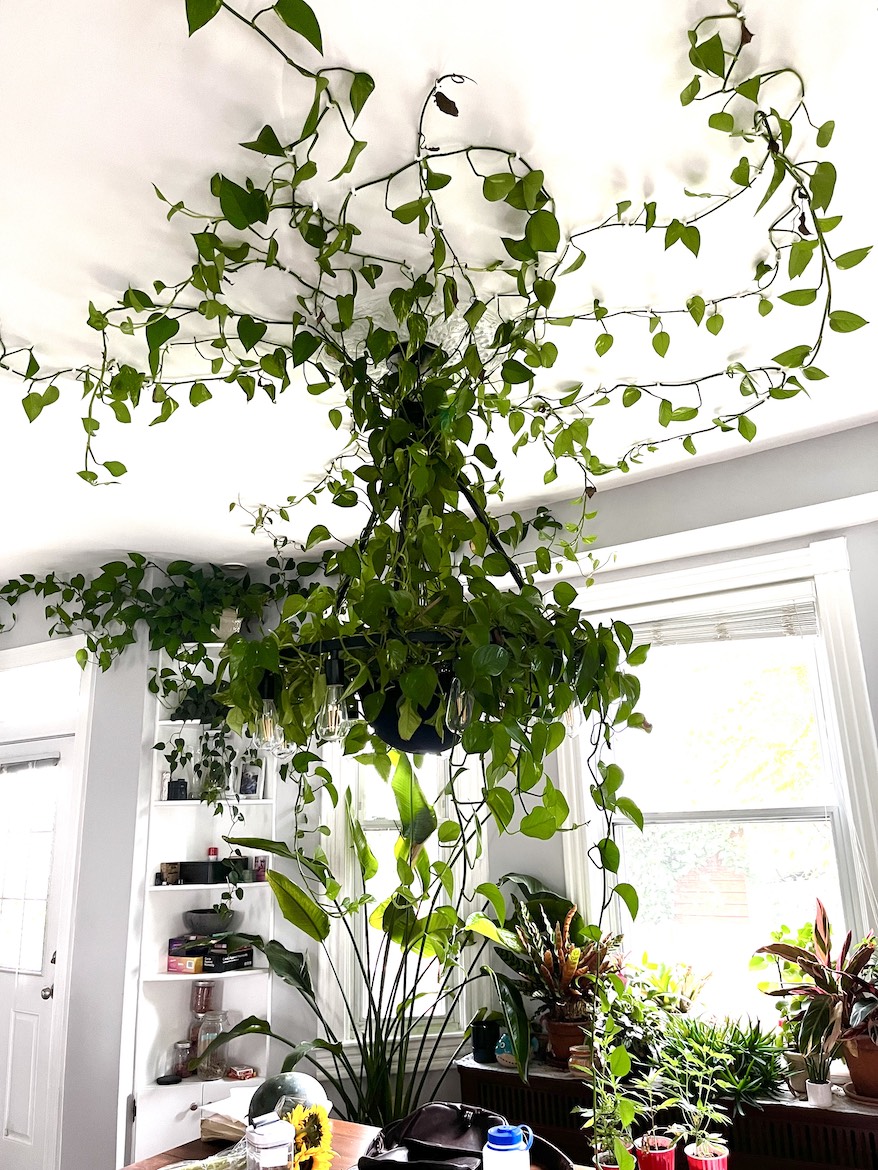Training a plant is essentially guiding where a plant spreads it tendrils and leaves. It involves installing a guide object, typically a pole, to direct that spread and also to provide stability. Typically, the guide object is used to train a houseplant to grow upward. And often, that vertical mobility is what helps them reach their full potential.
According to Terry Huang, botanist and director of living collections at South Coast Botanic Garden in California, certain plant species that originate from tropical and subtropical environments (like philodendrons) require vertical growth to reach their full height and leaf-growth potential. That’s largely due to how such plants grow in their natural habitats. “They start off on the forest floor and scramble up,” he says. “Their leaves get bigger and more intricate-looking because they get more light, and they finish their life cycle at the top of the rainforest where there’s plenty of light and they’re doing their thing.”
While you likely don’t live in a rainforest, you can replicate a similar effect in your home if you want your plants to grow vertically rather than horizontally. Without putting a support in place to encourage a plant to climb up, plants will grow outward and their vines and tendrils will hang down. This is a perfectly healthy growth pattern for plants that naturally climb. For example, without training a monstera, “it’ll just kind of grow sideways and you’ll just have to re-pot it a bit more often,” Huang says.
The benefits of training your houseplants
Training a houseplant that naturally grows vertically to do just that is beneficial for its overall health. According to Danuelle Doswell and Mignon Hemsley, cofounders of the indoor plant company Grounded, replicating your plant’s natural habitat at home as much as possible helps keep it healthy and allows it to grow to its full strength and size. “The more you learn about where [the plants] come from, the more you’re able to re-create that in your space,” Doswell says.
Training plants that climb to grow upward is part of that, and the people who do it can typically expect their plants to grow stronger roots and larger, more intricate leaves.

The types of houseplants that benefit the most from training
Because many common houseplants are of a tropical origin, “at least 50 percent of your more common houseplants will need a support of some kind,” says Jim Salyards, horticulturist and director of horticulture at Filoli, an early 20th century preserved estate with more than 16 acres of gardens. This includes vining plants like monstera (Monstera deliciosa), pothos (Epipremnum aureum), philodendrons, and string of hearts (Ceropegia). If you want to change the shape of your plant, training can be helpful, too.
He says plants with leaves that are arranged in a more rounded, rosette-like shape need this less; for example, Chinese money plants (Pilea Peperomioides) and spider plants (Chlorophytum comosum) fall in this category. It’s not necessary for plants whose growths naturally hang either, like string of pearls (Cenecio rowleyanus).
When is the best time to train your plant?
Start training your plant when it begins to sprout new growths and when its existing growths are getting longer. This means that your plant is doing well, and it’s a good time to start directing it. “Your houseplant is happy and healthy and growing really well when it is sending out really long shoots,” Salyards says. You could also start as soon as you get your plant, but likely, it’s not necessary. “You need it to grow long enough to get it on the support,” he adds.
“Your houseplant is happy and healthy and growing really well when it is sending out really long shoots.” —Jim Salyards, horticulturalist and Director of Horticulture at Filoli
How to train your houseplant
Actually starting the process of training your houseplant is easy, the experts say.
First, pick which guide object you’ll use. Doswell and Hemsley suggest a moss pole, which is a sturdy stick covered in moss. These are stable and wide, so the plant has plenty to grab onto. The plant’s roots can also penetrate the moss and anchor the plant to it. Plus, the moss pole can also act as a self-watering mechanism for the plant. “You can spray the pole, and as long as you keep the moss moist, the plant can get water and nutrients from the moss pole as well,” Doswell says. Misting the moss pole also encourages the plant’s roots to latch onto it, which can help it grow vertically. If a moss pole doesn’t fit the look you’re going for, Hemsley also recommends a bamboo stick, which is skinnier, but also very sturdy.
Next, install the pole in the plant’s pot so it points straight up. Once the pole is in, secure the tendrils and shoots you’d like to direct against the pole using plant ties (some types are made of Velcro, and others are coated wires). Be careful not to affix it too tightly and crush the plant’s offshoots, but be sure that the tie is secure.

Regarding pole size, keep in mind that you don’t have to start with a towering pole, Doswell and Hemsley say. Rather, buy one that fits the plant’s existing shoots, with some extra room for it to grab as it grows. Then, be ready to add length as your plant needs it.
Once the training guides are in, don’t forget to perform the regular maintenance required to keep your plant healthy and at its best, like occasional pruning and repotting your plant if it outgrows its container. (Doswell and Hemlsey say you likely will need to repot your plant when you start training it or just after because of how strong it’ll become). Check your plant every month or so to make sure it’s growing in the direction you want it to and doing well. Finally, enjoy its guided growth, you responsible plant parent, you.
Our editors independently select these products. Making a purchase through our links may earn Well+Good a commission.
